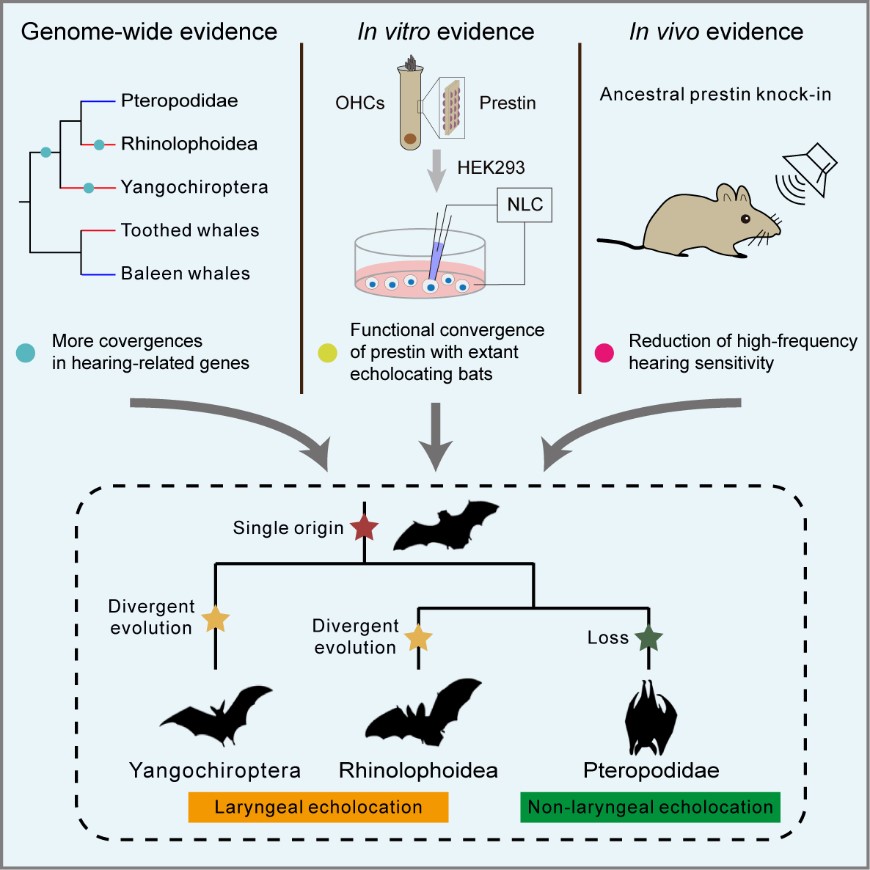A research team led by Prof. SHI Peng from Kunming Institute of Zoology of the Chinese Academy of Sciences reported the new evidence for a single origin of laryngeal echolocation in bats. The finding was published in iScience on 18th March.
Studies on the origin of complex traits largely rely on fossil evidence. However, in most cases, it is difficult to time the origin of complex traits and make a clear judgment for the evolutionary path, due to the accidentals of fossil formation and discovery, as well as the limitations of fossil morphology. A case in point is when and how echolocation originated and evolved in bats. Some found fossil evidence supports that echolocation originated from the common ancestor of bats (the "single-origin" hypothesis), while others support that echolocation originated independently from different echolocation bat lineages (the " independent-origin" hypothesis).
To address this question, this study performed evolutionary analyses of molecular convergence between the last common ancestors of bats (LCAB), the last common ancestors of non-laryngeal echolocating Pteropodidae (LCAP), and the echolocating toothed whales. Compared with nonecholocating controls and neutral expectations, the molecular convergences were enriched in hearing-related genes for LCAB and extant echolocating bats, but not for LCAP.
The resurrection of the echolocation-related gene prestin showed that the LCAB prestin functioned similarly to those of the extant echolocating bats but differed from the LCAP prestin.
Furthermore, the high-frequency hearing sensitivity of the LCAP-prestin knock-in mice decreased with lower cochlear outer hair cell function compared with the LCAB-prestin knock-in mice.
“We combined evidence from molecular convergence analysis, cellar function experiments, and auditory assessments in the transgenic mice, supporting that echolocation in bats originates from their common ancestor and has undergone divergent evolution in extant echolocating bat lineages,” said Prof. SHI Peng, an evolutionary biologist in Kunming Institute of Zoology who has been committed to systematically studying the traits of echolocation by using comparative genomics, functional genomics, and evolutionary genetics. “These results laid an important foundation for further studies on the molecular genetic mechanism of echolocation”.
This study, entitled “Molecular convergence and transgenic evidence suggest a single origin of laryngeal echolocation in bats”, was published in iScience on 18th March. Weblink: https://www.cell.com/iscience/fulltext/S2589-0042(22)00384-4. Prof. SHI Peng and Prof. LIU Zhen are the co-corresponding authors. This project was financially supported by grants from the National Natural Science Foundation of China (31922010, 31930011, 31871270), the China National Center for Biotechnology Development (2020YFC0847000), the Key Research Program of the Chinese Academy of Sciences (KJZD-SW-L11), and the Yunnan Provincial Science and Technology Department (2019FI008).

The red and blue branches indicate echolocating and nonecholocating animals, respectively.
(Image by Liu et al., DOI: 10.1016/j.isci.2022.104114.)
(By CHEN Peng, Editor: YANG Yingrun)
Contact:
SHI Peng
ship@mail.kiz.ac.cn
